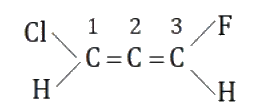The pair of electrons in the given carbanion, is present in which of the following orbitals?
sp
2p
Step by step video & image solution for The pair of electrons in the given carbanion, CH_(3)C-=C^(Theta) is present in which of the following orbitals? by Chemistry experts to help you in doubts & scoring excellent marks in Class 12 exams.
Updated on:21/07/2023Topper's Solved these Questions
- ORGANIC CHEMISTRY : SOME BASIC PRINCIPLES AND TECHNIQUES Book:AAKASH INSTITUTE ENGLISHChapter:ORGANIC CHEMISTRY : SOME BASIC PRINCIPLES AND TECHNIQUES Exercise:Assignment(Section-D)(Assertion - Reason Type Questions)
Explore 15 Videos
- ORGANIC CHEMISTRY : SOME BASIC PRINCIPLES AND TECHNIQUES Book:AAKASH INSTITUTE ENGLISHChapter:ORGANIC CHEMISTRY : SOME BASIC PRINCIPLES AND TECHNIQUES Exercise:Assignment(SECTION B)
Explore 6 Videos
- MOCK_TEST_20Book:AAKASH INSTITUTE ENGLISHChapter:MOCK_TEST_20Exercise:EXAMPLE
Explore 29 Videos
- ORGANIC CHEMISTRY: SOME BASIC PRINCIPLE AND TECHNIQUESBook:AAKASH INSTITUTE ENGLISHChapter:ORGANIC CHEMISTRY: SOME BASIC PRINCIPLE AND TECHNIQUESExercise:TRY YOURSELF
Explore 28 Videos
Similar Questions
Consider the following molecule

If π− electron cloud of C1−C2 is present in the plane of paper then which of the following is/are correct
View SolutionAccording to V.B.T., atoms of element form bond only to pair up their unpaired electrons present in ground state or excited state. This pairing of unpaired electron will take place by overlapping of orbitals each one having one unpaired electron with opposite spin.
Which of the following orbital cannot form δ-bond ?
View Solution
Knowledge Check
The shape of carbanion [CH3]− is:
linear
bent
pyramidal
tetrahedralAlinearBbentCpyramidalDtetrahedralThe number of electrons present in the valence shell of carbon bearing negative charge in a carbanion is
A4B6C7D8How many primary, secondary, tertiary and quaternary carbon atoms are present in the following compound?
CH3−C∣CH3H−CH2−CH3∣C∣CH3−CH3AOne primary, two secondary and one tertiaryBFive primary, three secondaryCFive primary, one secondary, one tertiary and one quaternaryDfour primary, two secondary and two quaternary
According to V.B.T., atoms of element form bond only to pair up their unpaired electrons present in ground state or excited state. This pairing of unpaired electron will take place by overlapping of orbitals each one having one unpaired electron with opposite spin.
Which of the following orbital cannot form δ-bond ?
View SolutionCalculate the number of exchange pairs of electrons present in configuration of Cu according to Aufbau principle. Considering 3d orbitals.
View SolutionOut of the folowing paris of electorns, identify the pairs of electrons present in degenrate orbitals.
View SolutionThe molecule , which are electron deficient having tendency to form back bonding, in which transfer of lone pair of electron from filled orbital of an atom to the vacant orbital of the adjacent atom. While some electron deficient species which are not capable to form back bonding, then driving forces occurs for dimerisation/polymerisation to achieve octet temporily or permanently by the monomeric species.
Which of the following readily gets combined with lewis base (NH3,CH3NH2,C5H5Netc)
View SolutionReaction intermdiates are short lived species and are highly reactive. They are formed by heterolytic and homolytic bond fission. There are various types of reaction intermediates in which the most important are carbocation , carbanion and free radical.
Carbocation is an organic species in which carbon have positive charge and six electrons in its outermost shell. The stability of carbocation can be increased by positive inductive effect, hyperconjugation and delocalisation. If α-atom with respect to carbocation has one or more lone pair of electron then lone pair of electron strongly stabilises the carbocation due to octet completion.
Species in which carbon have negative charge is called carbanion. Carbanion carries three bond pairs and one lone pair. The stability of carbanion can be increased by negative inductive effect, negative mesomeric effect and delocalisation.
Free radical is a species which have seven electrons in its outermost shell. The stability of free radical can be increased by hyperconjugation and delocalisation.
The stability order of following free radicals is:
C6H5CIH2⋅CH2 CH3CIIH2⋅CH2 C6H5 III⋅CH2 CH⋅3IV
View Solution